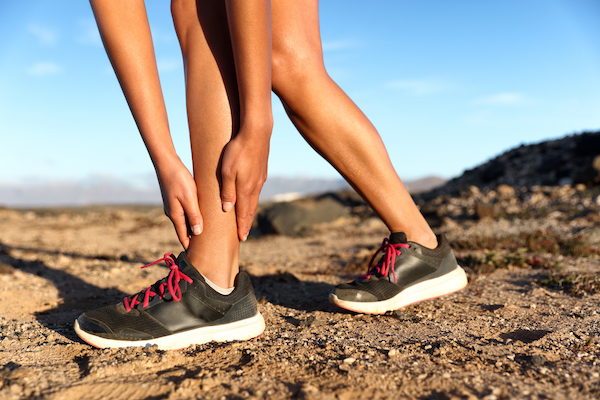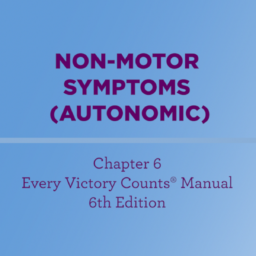Do your fingers tighten and cramp when you write? Does your calf tend to cramp during or after exercise? The reasons may be due to nutrition, hydration, or other lifestyle choices, or, they could also be symptoms of dystonia.
What is dystonia?
Dystonia is an involuntary muscle contraction in which the brain tells the muscles to tighten and move even though you don’t want them to. These involuntary movements can cause painful and awkward postures, writer’s cramp and calf cramps, curled and clenched toes, and excessive eye blinking. The contractions can range from mild to severe and can be sustained or intermittent. They can also be so painful that they interfere with accomplishing your day to day activities. When people with Parkinson’s talk about pain, it’s often due to dystonia.
Dystonia, however, is not only a symptom of Parkinson’s, but it’s also the third most common movement disorder. People can have dystonia with Parkinson’s and Parkinson’s without dystonia. An estimated 17% of people with Parkinson’s experience dystonia.
What does dystonia feel like?
For some people, dystonia feels like a Charlie horse, which can be so painful that it wakes you up at night. For some, it feels like opposing muscles, muscles that work in pairs, are competing with each other. For example, when your bicep muscle contracts, your tricep muscle relaxes or elongates. In dystonia, both muscles want to contract at the same time, and it feels like they’re fighting. For some people living with Parkinson’s, dystonia is the most distressing symptom they experience.

What’s the difference between dystonia and dyskinesia?
Both dystonia and dyskinesia affect your muscles and joints; however, there are distinct differences between them that require unique treatments. Dystonia is a movement disorder that can occur with or without a Parkinson’s diagnosis, while dyskinesia is often a side effect people experience as a result of taking Parkinson’s medications. Though both involve similar abnormal movements of the arms, legs, neck, and face, dystonia is characterized by more sustained muscle contractions and pain.
What parts of the body can be affected by dystonia?
Muscle contractions can occur in a single area of your body (focal dystonia), in two or more adjacent areas (segmental dystonia), or in all areas of your body (general dystonia). Parts of the body that can be affected include:
Jaw and tongue
- You might experience involuntary opening and closing of your jaw and difficulty chewing or swallowing. Dystonia of the tongue can also cause drooling and slurred speech.
Eyelids
- Even though spasms in the eyelids are generally not painful, rapid blinking and involuntary contractions of the muscles around the eyes can affect your vision.
- Using “sensory tricks,” such as putting pressure on your eyebrows, singing, laughing, or chewing, seem to distract the brain and may relieve dystonia on your eyelids.
Vocal cords
- Contractions in your vocal cords can cause you to have a breathy, whispering voice, which can make you sound hoarse or tight.
- Yawning may ease dystonia in your vocal cords.
Neck
- Overactivation of your neck muscles can cause your head to turn repetitively side to side or back and forth, which can cause pain.
Hands
- Sometimes involuntary cramping and spasms are brought on by task-specific movements, such as playing an instrument (musician’s dystonia) or writing or typing (writer’s dystonia).
Legs and feet
- A common manifestation of dystonia in people with young-onset Parkinson’s disease (YOPD) causes the toes to curl and the foot and ankle to turn in (inversion). This may occur when you’re walking or running or doing some other type of movement.
Trunk
- Though this is less common, twisting of the trunk can cause contorted posture and pain.
Non-motor symptoms
- Depression and anxiety can increase with dystonia, especially if the experience of dystonia makes you more apt to withdraw socially.
All over pain
- Even though the prevalence of pain in people with Parkinson’s is estimated to be 30-85%, it’s often underreported and underrecognized. People are often embarrassed to mention pain because they think it’s “all in their head” and will make them sound like a complainer. However, dystonic pain can decrease your quality of life; so, don’t be afraid to talk to your doctor about it. There are treatments.
When can dystonia occur?
Each person’s experience with Parkinson’s and dystonia is unique. Dystonia can occur unexpectedly or during repetitive actions, such as writing or golfing. It can be brief or prolonged. It can occur as a response to your levodopa therapy, even if your medication is working optimally. And, it can occur at different times throughout the day or can be cyclical.
Early morning
- Dystonia tends to be worse in the early morning. Wearing off of medications taken at night can cause dystonia in the morning with symptoms such as toe-curling and foot inversion. Painful cramping may go away after your first dose of medicine. (Note: OFF periods are when your medication is not working ideally, and your motor and non-motor symptoms return. Click here to learn more about the four different types of OFF periods.)
ON period dystonia
- Curiously, dystonia symptoms can occur when your medication is working at its best or peak dose, also called being ON.
Stage-specific
- In retrospect, some people realize they had dystonia long before they were officially diagnosed with Parkinson’s.
- Dystonia is a common early symptom of young-onset Parkinson’s (YOPD) and may first be recognized during exercise. Dystonia is not likely to be a presenting symptom of people who are diagnosed with Parkinson’s at a later age.
- As your Parkinson’s progresses, you may start to develop dystonia.
How can you manage symptoms of dystonia?
Different approaches to treatment are available. Most of them involve a combination of self-care (focusing on exercise, sleep, and healthy eating), medication adjustments, and time with a physical therapist.
Keep a diary
- By tracking the onset of dystonia and the timing of medication, you can determine if there’s a pattern between the two.
- Do your symptoms occur before your first dose of medication in the morning because your nighttime medication is wearing off?
- Do your symptoms occur when your medication is at its peak?
- Keep your tracking current and show this diary to your physician. Dystonia symptoms can be relieved by adjusting the dose and frequency of your medication and/or adding another medication that targets dystonia.
Exercise, stretch, and strengthen
- Even if you don’t feel like it, exercising every day can increase flexibility in your muscles and joints, reduce pain and discomfort, and improve circulation. Exercise can increase the secretion of your “happy hormones,” improve your mood, and decrease anxiety and depression.
- If you have discomfort in your calves, ankles, feet, or toes, click here and try the eight exercises physical therapist Sarah King recommends.
Sleep well
- Creating a sleep routine that involves waking up at the same time each day, limiting daytime naps, and removing sources of blue light in your bedroom from computers, TVs, and phones can help you have a better night’s sleep and decrease your dystonia.
- Click here for more tips on improving the quality and quantity of your sleep.
Eat well
- By choosing a variety of healthy, nutritious foods at the grocery store, you will eat healthier at home. Pick fruits and vegetables to create a colorful, healthy plate or blend them in a smoothie for a refreshing snack.
- Click here if you have dystonic pain and want some tips on how to maximize your nutrition and the experience of eating.
Trick your body
- Using the sensory trick called “geste antagoniste” in which you lightly touch a different part of your body than the one that is cramping or curling can sometimes quiet the dystonia. For example, touching your chin may prevent your neck from twisting.
Try Botox
- If dystonia is in one easily accessible muscle, injections of botulinum toxin (Botox) in the contracted muscle can cause it to relax and return to a normal state.
Consider muscle relaxants
- Since dystonia is due to the contraction of muscles, doctors sometimes prescribe muscle relaxants.
Talk to your doctor about DBS
- If dystonia is generalized all over your body and affects muscles that are inaccessible, and you have tremor and dyskinesia, you may want to discuss deep brain stimulation (DBS) with your care team.
Try complementary therapies
- Participating in yoga, dance, meditation, tai chi, and acupuncture help some people reduce their symptoms.
See a PT, OT, or SLP
- Many people who experience dystonic pain find that meeting regularly with a physical therapist, occupational therapist, and/or speech-language pathologist is another good way to manage their symptoms.
Dystonia and the pain associated with it are often underreported and not addressed because people ignore the symptoms. However, because dystonia can affect your quality of life, it’s essential to educate yourself about ways to manage your symptoms and not dismiss them as just a part of getting older. From exercise, sleep, medication adjustments, and healthy eating, there are many actions you can take today to live better with dystonia and Parkinson’s.
To download this post as a PDF, click here.
Further Learning
Dystonia Medical Research Foundation
Dystonia Coalition
Diagnosis and Treatment of Dystonia
What’s the difference between a Parkinson’s disease patient with dystonia and a dystonia patient with Parkinson’s symptoms?
Dystonia and Parkinson’s disease: What is the relationship?
How to treat Parkinson’s dystonia
Pain and Parkinson’s with Dr. Janis Miyasaki
Want More Practical Articles Like This?
Much more can be found in our Every Victory Counts® manual. It’s packed with up-to-date information about everything Parkinson’s, plus an expanded worksheets and resources section to help you put what you’ve learned into action. Request your copy of the Every Victory Counts manual by clicking the button below.
Thank you to our 2020 Peak Partners, Amneal and Kyowa Kirin, with special support from Adamas, for helping us make printing, distributing, and shipping the Every Victory Counts manual for free possible.














